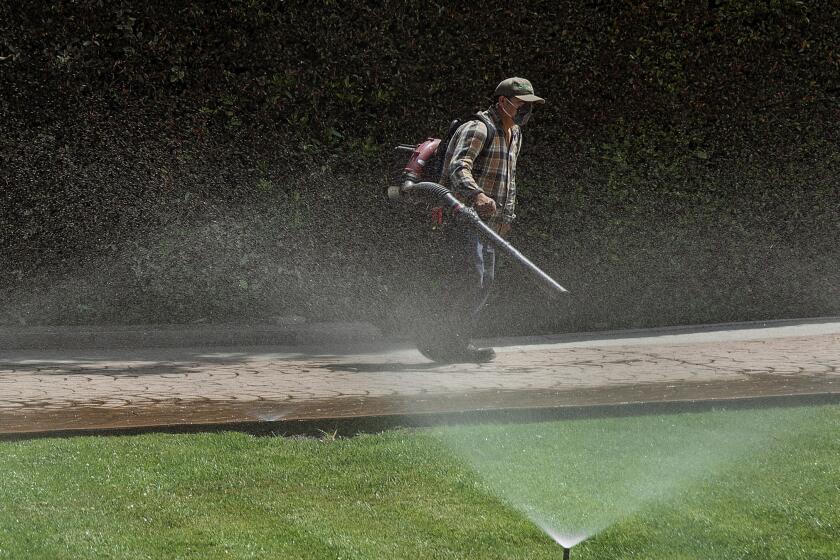Strokes of Genius: Tips to Paint Smoothly
- Share via
If you’re willing to do the work yourself, painting is the simplest way to spruce up a dull room. One gallon, enough to cover an average bedroom, can be had for as little as $10; even a top-quality paint will be under $50.
Within your means, don’t scrimp on the paint and primer or undercoat. You’ll get the best results if you buy a premium quality paint recommended by a reliable paint retailer. Buying a less expensive paint won’t save money. It will cover fewer square feet and isn’t likely to wear as well as a better quality paint.
Color and shade
Think about what paint palette suits your style. Consider the mood you want to create.
Pastels such as soft blue and pale pink add a fresh, light look that visually enlarges a room but will show dirt more easily than a darker color will. Quiet, soothing neutrals such as beige, cream or gray are relaxing and make a fine backdrop for a prized art collection. Many modern nurseries are done in black, white and red, which skirts the pink-blue question; the idea is based on indications that newborns don’t see colors but can distinguish bold shapes. Playful primary colors--red, blue, yellow--are fun for a child’s, play, game or family room. Bold jewel tones such as emerald green or sapphire blue make a dramatic statement of rich elegance for formal rooms.
A shade on a paint chip will look much more intense on a wall. Some professionals advise buying two shades lighter than what you want. Another tip: Buy a quart of paint and try it on a wall or section of wall. Leave it on for several days. See how it looks with the lights on and off, on a cloudy morning, a sunny afternoon, at night. Lighting has a dramatic effect on the way color is perceived.
How much to buy
As a rule of thumb, one gallon of paint provides one coat for four 8-foot-high walls in a 12-by-15-foot room. You’ll need more for rough-textured walls. Figure another half-gallon for the ceiling.
To keep from running out of paint in the middle of a job, always buy a little more than you think you’ll need.
Buy gallons instead of quarts. You’ll spend about the same for one gallon as for two quarts. Thus you’ll be getting an extra half-gallon of paint free. Save it for touch-ups. Most trim paints cover between 350 and 400 square feet of surface per gallon. Painters allow about 8 square feet of paintable area for each window and about 25 square feet of area for each door. Extra paint is needed for the window’s trim or casing and its jamb.
To determine the surface area of base and ceiling molding, estimate it at 6 inches wide (regardless of actual width) and multiply this times its length in inches. Divide this number by 144 to arrive at the square-foot surface area. The average room does not require a lot of trim paint. A quart will usually do it. If you need 2 or 3 quarts, buy a gallon.
Into the mix
A paint-stirring attachment that fits on a power drill is handy for mixing paints. Use a variable speed drill on a slow speed. To avoid battling bubbles, don’t use the stirrer for any clear varnish or other finish that says “Do Not Shake Can” on the label.
Cut off the top of a clean half-gallon paper milk carton and use it for mixing (or just holding) small amounts of paint. The paint won’t stick to the wax-coated interior and the carton’s corner makes a good pouring spout.
To make a wooden paint-stirring tool more effective, drill several holes along its length to let the paint flow back and forth. When drilling, back the stirrer with a block of scrap wood to keep it from splitting.
A favorite method of busy do-it-yourselfers is to leave the paint cans in the car trunk until you’re ready to paint. Driving around for a few days should have it mix up just fine.
Taking lumps
Strain lumps by pouring the paint into an empty can covered with cheesecloth. Hold the cheesecloth in place with a rubber band, tape or string around the can.
Another way to remove lumps is to cut a circle of fine-mesh screening one-quarter inch smaller in diameter than the can. Drop it onto the surface of the paint and push it slowly to the bottom with a paint stirrer. As the screen travels down, it will carry the lumps with it.
Writing on the walls
For a flat paint finish on an interior wall that still will allow handprints and dirt to wash off, add a quart of interior semigloss latex to each gallon of flat latex wall paint, mixing thoroughly. In high-traffic areas, such as a family room or a child’s room, add two quarts of semigloss to each gallon of flat paint.
Stair power
Keep traffic moving when you paint stairs. Paint every other step, let the paint dry and then finish the rest. Or paint half the width of each step, wait for the paint to dry, and then finish the other half.
Farewell fumes
When painting, good ventilation is a must to combat the physical side effects of noxious solvents. But the fumes of some paints persist even in a well-ventilated room. To reduce the odor, add a few drops of vanilla extract to the paint, up to one tablespoon per gallon. It won’t affect the way the paint performs, and the wet paint won’t be so smelly.
Neatness counts
To avoid paint accumulating in the lid groove of a paint can, use a nail to punch several holes in the groove before you paint. When you reseal the can, the lid will cover the holes and form a tight seal.
To avoid a messy paint can rim, bend a piece of coat hanger into a squared U-shape and tape it securely over the top on one side of the paint can. Use the wire instead of the rim of the can to tap excess paint from your brush.
If you don’t have a funnel to pour paint neatly, hold a pencil across the opening of the pouring can. The paint will follow the pencil and pour neatly into its new container.
Use a little putty or adhesive to attach a sturdy paper plate to the bottom of a paint can. The rim of the plate will catch paint runs and drips the way a saucer catches drips from a cup.
Storing paint
* When storing leftover paint, mark a line on the outside of the can to indicate how much is left. You can see if you have enough paint for a job.
* Wipe away the paint in the can’s rim before sealing. Then stretch a piece of plastic wrap over the rim. Tap the lid in place with light hammer blows on alternate sides of the lid.
* Rust and paint flakes often form in stored latex paint. Pour the paint into a plastic or glass jar with a screw lid. Rub a bit of petroleum jelly on the threads of the lid.
* You can keep leftover paint in a resealable plastic bag. Squeeze the air out and seal the bag. Put the bag in the original can and tap the lid closed.
* A skin will form on any leftover paint after a while. To avoid a messy removal job, store the paint can upside down. Turn the can right side up when it’s time to reopen it. The skin will be at the bottom of the can.
Try blowing into the can before putting on the lid. Carbon dioxide in the breath prevents paint from oxidizing. Printers use this system to prevent a skin from forming on unused inks.
Another idea is to cut a piece of wax paper the same diameter as the inside of the can and drop it down on top of the paint. When you paint again, remove the paper and the paint under it will be ready to stir and use without lumps or pieces of dried paint skin to strain out.
Perhaps the best method is to pour a thin layer of the proper solvent for the type of paint onto the surface of the paint left in the can. Use just enough thinner to cover the surface of the paint. Then, the next time you use the paint, simply stir the thinner into the paint. No skin forms, and there is nothing to fish out, dispose of and make a mess with. As a bonus, most paints will spread much more easily when they are slightly thinned.
(BEGIN TEXT OF INFOBOX / INFOGRAPHIC)
Always Judge a Bristle by Its Paint
Tips on paint brushes:
Selection
Brush material should be determined by your choice of paint. A brush with polyester or nylon bristles is suitable for latex or oil paint. If you buy only one brush, make it polyester.
Brushes made from hog bristle (sometimes called China bristle) are best with oil paints and get limp when used with latex paint. High-quality bristle brushes are expensive. Don’t buy the inexpensive ones, which tend to lose bristles.
Cleaning
To make a paintbrush easier to clean, wrap masking tape around the metal ferrule and about one-half inch over the base of the bristles.
Rather than drying on the bristles, paint will collect on the tape. To clean up, remove the tape and clean the wet paint that remains on the bristles.
To paint a ceiling, wrap an old washcloth around the handle of your brush and secure it with a rubber band to absorb inevitable paint drips.
No cleaning
Disposable foam brushes are handy for touch-ups and small jobs. Make your own from scrap three-fourths-inch foam padding. Cut the foam to size with a utility knife, and angle the tip. Snap on a spring-type clothespin for a handle and you’re ready to paint.
If you’re working with oil-base paint, don’t clean brushes and rollers you’ll use the next day. Wrap them in plastic bags and stick them in the freezer. When ready to paint, thaw for about 45 minutes. If using latex paint, you’ll have to wash your tools each night.




